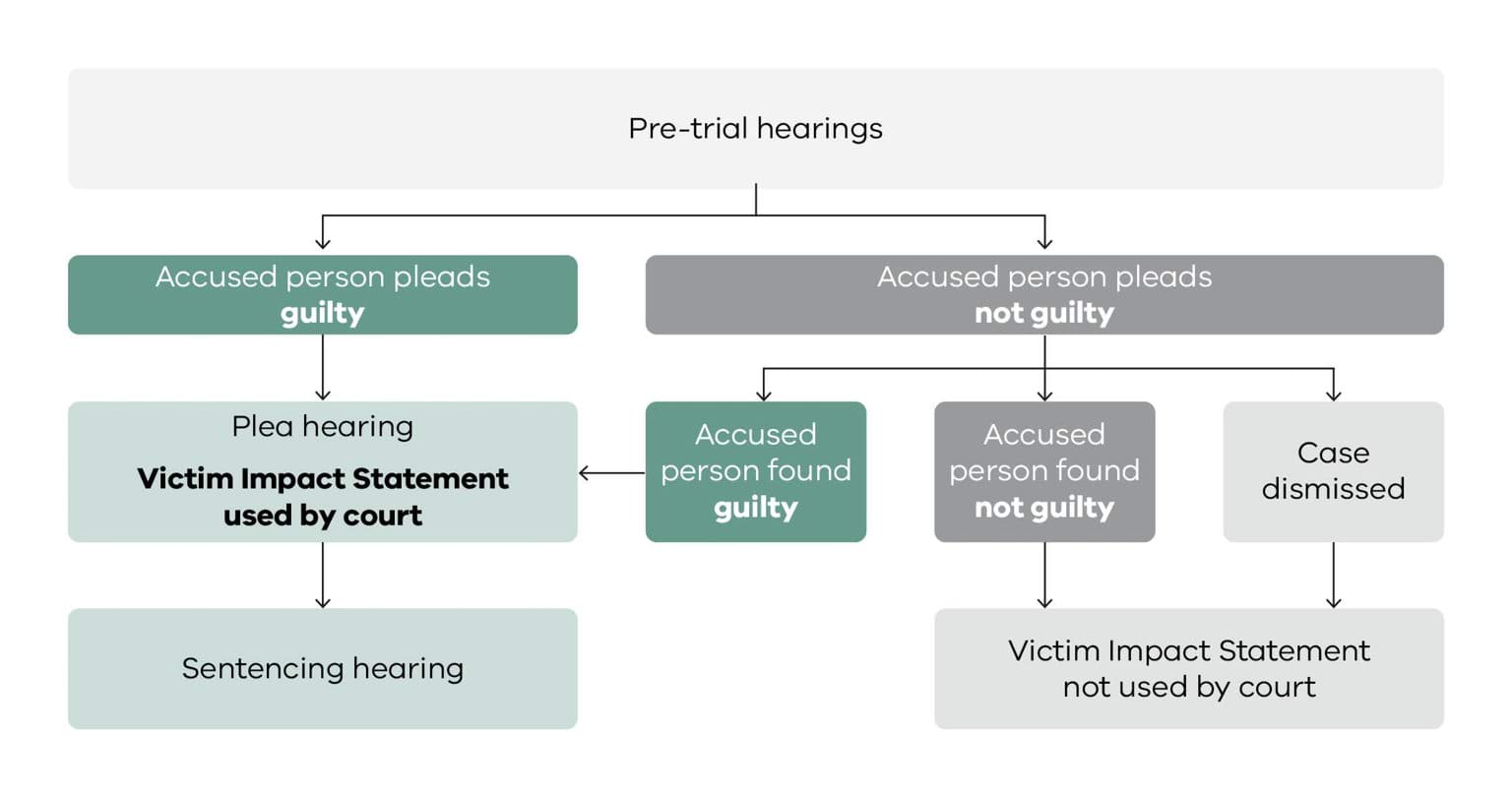A Victim Impact Statement is used in the plea hearing to tell the court how the crime has affected you.
If you receive a summons or subpoena to give evidence about your Victim Impact Statement, you must go to court.
A Victim Impact Statement tells the court how a crime has affected you and any victim of any crime can make one.
If you choose to make a Victim Impact Statement:
- it will be used at the plea hearing
- the judge may talk about it at the sentencing hearing when explaining the penalty (sentence)
- it may be used at any appeal hearings.
You will need to:
- give it to the prosecution legal team so they can submit it to the court
- follow rules about what you can say in the statement, or some or all of it will not be used.
You can find out more about making a Victim Impact Statement.
The plea hearing
- When the prosecution and the defence lawyers provide information to the judge or magistrate to help them decide on the penalty (sentence) the offender will receive.
- Happens after the offender is found guilty or pleads guilty, but before they are sentenced.
After the plea hearing, there is a sentencing hearing. This is when a judge gives the offender their sentence.
This diagram does not show all the different types of hearings that may happen. It only shows when your Victim Impact Statement can be presented in court. Learn more about the types of court and court hearings.
When does a plea hearing happen?
In the Magistrates’ Court
In the Magistrates’ Court, the hearing, plea and sentencing can happen quickly – sometimes on the same day. Other times, a plea hearing is booked in for weeks or sometimes a few months after the first hearing.
In the Supreme Court and County Court
In the County and Supreme Courts, the plea hearing may be held on the same day someone is found guilty or pleads guilty or a day or two after.
But sometimes the plea hearing is booked for several weeks later or even months later. There are many different reasons why this can happen.
Going to the plea hearing
You do not have to go to the plea hearing, unless the court calls you to give evidence about what you have included in your Victim Impact Statement.
This is very rare, but if it does happen, you will get a letter called a subpoena and you must go to court.
You can learn more about:
Who can read my Victim Impact Statement?
When you submit a Victim Impact Statement it is important to remember that it becomes a public document. That means other people may be able to read it.
The judge or magistrate
They will:
- review your Victim Impact Statement to make sure it is admissible
- decide which parts can be read out loud in court, if you ask for that to happen
- use the statement, as one of many things, to decide what the penalty (sentence) for the offender should be.
The defence team and offender
The offender’s lawyer also gets a copy of your Victim Impact Statement. This means the offender may read it, even if it is not read aloud in court.
In the court
You can ask for all or some of your Victim Impact Statement to be read aloud in court at the plea hearing by:
- you
- a person of your choice (the court must approve this)
- the prosecutor.
To do this, before the plea hearing date, contact:
- the police officer in charge of the case (sometimes called the police informant) or
- the Office of Public Prosecutions (or your Victims and Witness Assistance Service Worker, if you have one) for cases being heard in the Supreme or County Courts.
You can also tell the court if there are any parts of your Victim Impact Statement you do not want read aloud. Tell the prosecuting team and make a note of it when you are writing your statement.
Your Victim Impact Statement must be admissible (allowed by the court rules) to be read aloud in court. If there is a concern that some parts of your statement will not be admissible, the prosecution team may ask to discuss it with you before the hearing.
If you are concerned about your privacy when reading your Victim Impact Statement aloud, you can ask the judge or magistrate to close the court room. If the judge or magistrate agrees, this means that the general public and media would not be allowed in the court room while you read it.
After the case
After the court case is over, your Victim Impact Statement becomes part of the official court file.
Any member of the public or even a journalist can ask to read a court file after a court case is over. Newspapers and other media cannot name sexual assault victims in their reports.
If the judge speaks about your Victim Impact Statement at the sentencing hearing, their comments will be made available to the media. If the case was heard in the Supreme Court, their comments will also be published in a public database at www.austlii.edu.au
Updated

